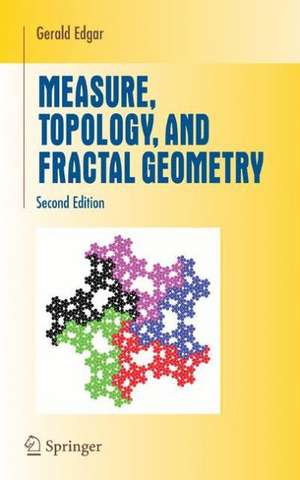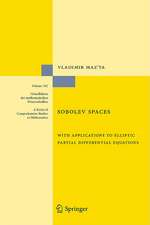Measure, Topology, and Fractal Geometry: Undergraduate Texts in Mathematics
Autor Gerald Edgaren Limba Engleză Paperback – 23 noi 2010
"In the world of mathematics, the 1980's might well be described as the "decade of the fractal". Starting with Benoit Mandelbrot's remarkable text The Fractal Geometry of Nature, there has been a deluge of books, articles and television programmes about the beautiful mathematical objects, drawn by computers using recursive or iterative algorithms, which Mandelbrot christened fractals. Gerald Edgar's book is a significant addition to this deluge. Based on a course given to talented high- school students at Ohio University in 1988, it is, in fact, an advanced undergraduate textbook about the mathematics of fractal geometry, treating such topics as metric spaces, measure theory, dimension theory, and even some algebraic topology...the book also contains many good illustrations of fractals (including 16 color plates)."
Mathematics Teaching
"The book can be recommended to students who seriously want to know about the mathematical foundation of fractals, and to lecturers who want to illustrate a standard course in metric topology by interesting examples."
Christoph Bandt, Mathematical Reviews
"...not only intended to fit mathematics students who wish to learn fractal geometry from its beginning but also students in computer science who are interested in the subject. Especially, for the last students the author gives the required topics from metric topology and measure theory on an elementary level. The book is written in a very clear style and contains a lot of exercises which should be worked out."
H.Haase, Zentralblatt
About the second edition: Changes throughout the text, taking into account developments in the subject matter since 1990; Major changes in chapter 6. Since 1990 it has become clear that there are two notions of dimension that play complementary roles, so the emphasis on Hausdorff dimension will be replaced by the two: Hausdorff dimension and packing dimension. 6.1 will remain, but a new section on packing dimension will follow it, then the old sections 6.2--6.4 will be re-written to show both types of dimension; Substantial change in chapter 7: new examples along with recent developments; Sections rewritten to be made clearer and more focused.
| Toate formatele și edițiile | Preț | Express |
|---|---|---|
| Paperback (1) | 387.87 lei 6-8 săpt. | |
| Springer – 23 noi 2010 | 387.87 lei 6-8 săpt. | |
| Hardback (1) | 393.09 lei 6-8 săpt. | |
| Springer – 26 noi 2007 | 393.09 lei 6-8 săpt. |
Din seria Undergraduate Texts in Mathematics
- 17%
 Preț: 362.13 lei
Preț: 362.13 lei - 17%
 Preț: 365.42 lei
Preț: 365.42 lei - 20%
 Preț: 466.83 lei
Preț: 466.83 lei -
 Preț: 400.42 lei
Preț: 400.42 lei -
 Preț: 298.00 lei
Preț: 298.00 lei -
 Preț: 364.40 lei
Preț: 364.40 lei - 8%
 Preț: 384.89 lei
Preț: 384.89 lei -
 Preț: 257.71 lei
Preț: 257.71 lei - 17%
 Preț: 395.93 lei
Preț: 395.93 lei -
 Preț: 380.26 lei
Preț: 380.26 lei -
 Preț: 339.36 lei
Preț: 339.36 lei -
 Preț: 372.26 lei
Preț: 372.26 lei -
 Preț: 370.77 lei
Preț: 370.77 lei -
 Preț: 440.01 lei
Preț: 440.01 lei -
 Preț: 402.33 lei
Preț: 402.33 lei - 17%
 Preț: 366.38 lei
Preț: 366.38 lei -
 Preț: 433.85 lei
Preț: 433.85 lei -
 Preț: 290.80 lei
Preț: 290.80 lei - 19%
 Preț: 368.78 lei
Preț: 368.78 lei -
 Preț: 400.42 lei
Preț: 400.42 lei - 19%
 Preț: 400.52 lei
Preț: 400.52 lei -
 Preț: 359.48 lei
Preț: 359.48 lei -
 Preț: 415.94 lei
Preț: 415.94 lei - 17%
 Preț: 373.59 lei
Preț: 373.59 lei -
 Preț: 407.62 lei
Preț: 407.62 lei -
 Preț: 407.96 lei
Preț: 407.96 lei -
 Preț: 358.10 lei
Preț: 358.10 lei -
 Preț: 280.65 lei
Preț: 280.65 lei - 17%
 Preț: 368.60 lei
Preț: 368.60 lei - 17%
 Preț: 367.24 lei
Preț: 367.24 lei -
 Preț: 395.09 lei
Preț: 395.09 lei -
 Preț: 424.14 lei
Preț: 424.14 lei -
 Preț: 304.91 lei
Preț: 304.91 lei - 13%
 Preț: 389.61 lei
Preț: 389.61 lei - 17%
 Preț: 362.67 lei
Preț: 362.67 lei - 15%
 Preț: 417.73 lei
Preț: 417.73 lei -
 Preț: 332.02 lei
Preț: 332.02 lei -
 Preț: 329.94 lei
Preț: 329.94 lei - 19%
 Preț: 492.82 lei
Preț: 492.82 lei -
 Preț: 396.24 lei
Preț: 396.24 lei -
 Preț: 390.08 lei
Preț: 390.08 lei - 15%
 Preț: 521.04 lei
Preț: 521.04 lei -
 Preț: 402.00 lei
Preț: 402.00 lei - 15%
 Preț: 531.72 lei
Preț: 531.72 lei - 15%
 Preț: 447.81 lei
Preț: 447.81 lei
Preț: 387.87 lei
Nou
Puncte Express: 582
Preț estimativ în valută:
74.22€ • 77.70$ • 61.41£
74.22€ • 77.70$ • 61.41£
Carte tipărită la comandă
Livrare economică 05-19 aprilie
Preluare comenzi: 021 569.72.76
Specificații
ISBN-13: 9781441925695
ISBN-10: 1441925694
Pagini: 296
Ilustrații: XVI, 272 p. 169 illus., 20 illus. in color.
Dimensiuni: 155 x 235 x 16 mm
Greutate: 0.42 kg
Ediția:Softcover reprint of hardcover 2nd ed. 2008
Editura: Springer
Colecția Springer
Seria Undergraduate Texts in Mathematics
Locul publicării:New York, NY, United States
ISBN-10: 1441925694
Pagini: 296
Ilustrații: XVI, 272 p. 169 illus., 20 illus. in color.
Dimensiuni: 155 x 235 x 16 mm
Greutate: 0.42 kg
Ediția:Softcover reprint of hardcover 2nd ed. 2008
Editura: Springer
Colecția Springer
Seria Undergraduate Texts in Mathematics
Locul publicării:New York, NY, United States
Public țintă
Lower undergraduateCuprins
Fractal Examples.- Metric Topology.- Topological Dimension.- Self-Similarity.- Measure Theory.- Fractal Dimension.- Additional Topics.
Recenzii
From the reviews of the second edition:
"As a non-specialist, I found this book very helpful. It gave me a better understanding of the nature of fractals, and of the technical issues involved in the theory. I think it will be valuable as a textbook for undergraduate students in mathematics, and also for researchers wanting to learn fractal geometry from scratch. The material is well-organized and the proofs are clear; the abundance of examples is an asset for a book on measure theory and topology." (Fabio Mainardi, MathDL, February, 2008)
"This is the second edition of a well-known textbook in the field … . The book may serve as a textbook for a one-semester (advanced) undergraduate course in mathematics. … the book is also suitable for readers interested in theoretical fractal geometry coming from other disciplines (e.g. physics, computer sciences) with a basic knowledge of mathematics. The presentation of the material is appealing … and the style is clear and motivating. … the book will remain as a standard reference in the field." (José-Manuel Rey, Zentralblatt MATH, Vol. 1152, 2009)
"As a non-specialist, I found this book very helpful. It gave me a better understanding of the nature of fractals, and of the technical issues involved in the theory. I think it will be valuable as a textbook for undergraduate students in mathematics, and also for researchers wanting to learn fractal geometry from scratch. The material is well-organized and the proofs are clear; the abundance of examples is an asset for a book on measure theory and topology." (Fabio Mainardi, MathDL, February, 2008)
"This is the second edition of a well-known textbook in the field … . The book may serve as a textbook for a one-semester (advanced) undergraduate course in mathematics. … the book is also suitable for readers interested in theoretical fractal geometry coming from other disciplines (e.g. physics, computer sciences) with a basic knowledge of mathematics. The presentation of the material is appealing … and the style is clear and motivating. … the book will remain as a standard reference in the field." (José-Manuel Rey, Zentralblatt MATH, Vol. 1152, 2009)
Textul de pe ultima copertă
For the Second Edition of this highly regarded textbook, Gerald Edgar has made numerous additions and changes, in an attempt to provide a clearer and more focused exposition. The most important addition is an increased emphasis on the packing measure, so that now it is often treated on a par with the Hausdorff measure. The topological dimensions were rearranged for Chapter 3, so that the covering dimension is the major one, and the inductive dimensions are the variants. A "reduced cover class" notion was introduced to help in proofs for Method I or Method II measures. Research results since 1990 that affect these elementary topics have been taken into account. Some examples have been added, including Barnsley leaf and Julia set, and most of the figures have been re-drawn.
From reviews of the First Edition:
"...there has been a deluge of books, articles and television programmes about the beautiful mathematical objects, drawn by computers using recursive or iterative algorithms, which Mandelbrot christened fractals. Gerald Edgar's book is a significant addition to this deluge. Based on a course given to talented high-school students at Ohio University in 1988, it is, in fact, an advanced undergraduate textbook about the mathematics of fractal geometry, treating such topics as metric spaces, measure theory, dimension theory, and even some algebraic topology...the book also contains many good illustrations of fractals..."
- Mathematics Teaching
"The book can be recommended to students who seriously want to know about the mathematical foundation of fractals, and to lecturers who want to illustrate a standard course in metric topology by interesting examples."
- Christoph Bandt, Mathematical Reviews
"...not only intended to fit mathematics students who wish to learn fractal geometry from its beginning but also students in computer science who are interested in the subject. [For such students] the author gives the required topics from metric topology and measure theory on an elementary level. The book is written in a very clear style and contains a lot of exercises which should be worked out."
- H.Haase, Zentralblatt
From reviews of the First Edition:
"...there has been a deluge of books, articles and television programmes about the beautiful mathematical objects, drawn by computers using recursive or iterative algorithms, which Mandelbrot christened fractals. Gerald Edgar's book is a significant addition to this deluge. Based on a course given to talented high-school students at Ohio University in 1988, it is, in fact, an advanced undergraduate textbook about the mathematics of fractal geometry, treating such topics as metric spaces, measure theory, dimension theory, and even some algebraic topology...the book also contains many good illustrations of fractals..."
- Mathematics Teaching
"The book can be recommended to students who seriously want to know about the mathematical foundation of fractals, and to lecturers who want to illustrate a standard course in metric topology by interesting examples."
- Christoph Bandt, Mathematical Reviews
"...not only intended to fit mathematics students who wish to learn fractal geometry from its beginning but also students in computer science who are interested in the subject. [For such students] the author gives the required topics from metric topology and measure theory on an elementary level. The book is written in a very clear style and contains a lot of exercises which should be worked out."
- H.Haase, Zentralblatt
Caracteristici
Bridges the gap between traditional books on topology/analysis and more specialized treatises on fractal geometry Contains plenty of examples, exercises, and illustrations Ideal for classroom use with a self-contained and careful presentation














